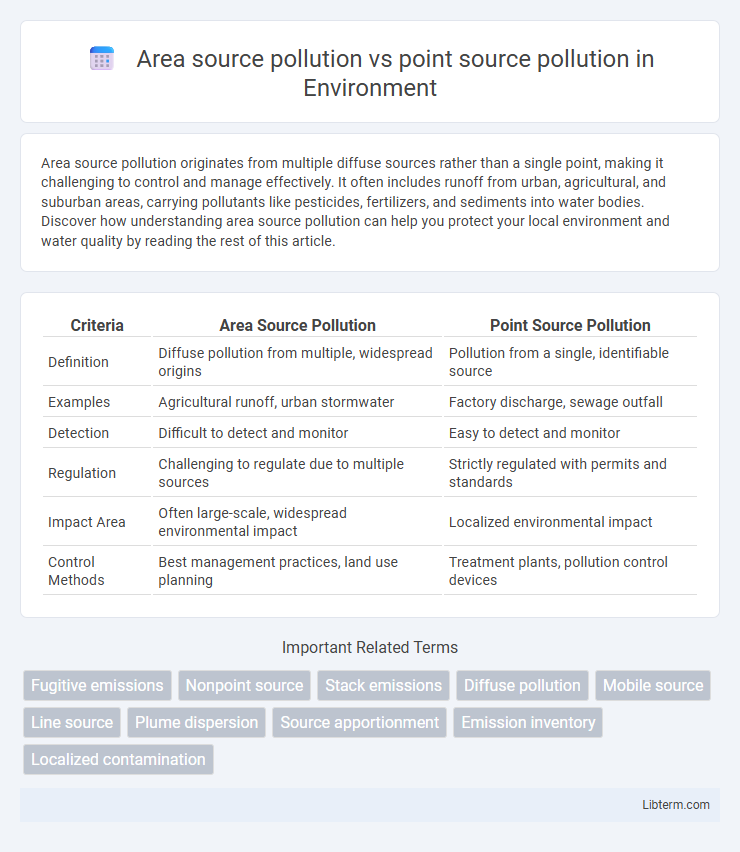Area source pollution originates from multiple diffuse sources rather than a single point, making it challenging to control and manage effectively. It often includes runoff from urban, agricultural, and suburban areas, carrying pollutants like pesticides, fertilizers, and sediments into water bodies. Discover how understanding area source pollution can help you protect your local environment and water quality by reading the rest of this article.
Table of Comparison
| Criteria | Area Source Pollution | Point Source Pollution |
|---|---|---|
| Definition | Diffuse pollution from multiple, widespread origins | Pollution from a single, identifiable source |
| Examples | Agricultural runoff, urban stormwater | Factory discharge, sewage outfall |
| Detection | Difficult to detect and monitor | Easy to detect and monitor |
| Regulation | Challenging to regulate due to multiple sources | Strictly regulated with permits and standards |
| Impact Area | Often large-scale, widespread environmental impact | Localized environmental impact |
| Control Methods | Best management practices, land use planning | Treatment plants, pollution control devices |
Introduction to Area and Point Source Pollution
Area source pollution originates from multiple diffuse sources over a large area, such as agricultural runoff or urban stormwater, making it challenging to identify and control. Point source pollution, in contrast, comes from a single, identifiable source like a factory discharge pipe or sewage treatment plant effluent, allowing for more targeted regulation and mitigation. Understanding the distinctions between these pollution types is essential for developing effective environmental management and pollution control strategies.
Defining Area Source Pollution
Area source pollution originates from multiple diffuse sources spread over a large geographic area, making it difficult to pinpoint a single discharge point. Common examples include runoff from agricultural fields, urban stormwater, and atmospheric deposition, which collectively contribute contaminants like nutrients, pesticides, and sediments. Unlike point source pollution, which comes from identifiable locations such as pipes or factories, area source pollution requires broad, integrated management strategies to effectively reduce environmental impact.
Defining Point Source Pollution
Point source pollution originates from a single, identifiable source such as a pipe, factory, or sewage treatment plant, making it easier to monitor and regulate. This type of pollution releases contaminants directly into water bodies or air through discrete channels, allowing for targeted control measures. Understanding the characteristics of point source pollution is crucial for environmental management and pollution mitigation strategies.
Key Differences Between Area and Point Source Pollution
Area source pollution originates from multiple diffuse sources spread over a large geographical area, making it challenging to identify a single point of emission. Point source pollution comes from a specific, identifiable location such as a factory discharge pipe or wastewater treatment plant outlet, allowing for easier monitoring and regulation. The key differences lie in their origin, with area sources linked to widespread activities like agriculture or urban runoff, while point sources are localized and often subject to stricter permit requirements under environmental laws.
Common Examples of Area Source Pollution
Area source pollution originates from numerous diffuse sources, making it difficult to pinpoint a single origin, unlike point source pollution which stems from identifiable locations such as factories or sewage treatment plants. Common examples of area source pollution include agricultural runoff carrying pesticides and fertilizers, urban stormwater runoff laden with oils and heavy metals, and residential activities generating lawn chemicals and pet waste. These pollutants collectively contribute to water quality degradation, soil contamination, and ecosystem imbalances over broad geographic regions.
Common Examples of Point Source Pollution
Common examples of point source pollution include discharge from wastewater treatment plants, factories, and oil refineries where pollutants enter water bodies through identifiable pipes or channels. Power plants releasing thermal pollution and sewage outfalls directly contribute specific contaminants to rivers and lakes. These concentrated sources are easier to monitor and regulate due to their defined locations compared to diffuse area sources.
Environmental Impact: Area vs Point Source Pollution
Area source pollution originates from diffuse sources such as agricultural runoff, urban stormwater, and atmospheric deposition, spreading contaminants over a wide region and complicating mitigation efforts. Point source pollution stems from identifiable, localized sources like industrial discharges, wastewater treatment plants, and oil spills, allowing for more targeted regulation and control. The environmental impact of area source pollution often results in widespread ecosystem degradation and cumulative water quality issues, whereas point source pollution typically causes concentrated damage with more immediate but potentially reversible effects.
Challenges in Monitoring and Regulation
Area source pollution presents significant challenges in monitoring and regulation due to its diffuse origin from multiple, often unidentifiable sources spread over large geographical areas, such as agricultural runoff or urban stormwater. Point source pollution, originating from a single, identifiable source like a factory discharge pipe, allows for more straightforward monitoring, regulation, and enforcement through permits and direct sampling. The complexity in controlling area source pollution arises from its nonpoint nature, variability in pollutant load, and the need for comprehensive watershed management strategies rather than targeted interventions.
Mitigation Strategies for Both Source Types
Mitigation strategies for area source pollution focus on implementing best management practices such as buffer strips, cover crops, and controlled use of fertilizers to reduce diffuse runoff and soil erosion. Point source pollution mitigation involves installing advanced treatment systems like sedimentation tanks, filtration units, and chemical treatments at identifiable discharge points to prevent contaminants from entering water bodies. Both source types benefit from regulatory frameworks, real-time monitoring, and community engagement to ensure compliance and promote sustainable pollution control.
Future Outlook on Pollution Management
Future pollution management will increasingly leverage advanced monitoring technologies and data analytics to differentiate and control area source pollution, which involves diffuse sources like agricultural runoff. Point source pollution, originating from identifiable locations such as factories and sewage treatment plants, will benefit from stricter regulatory enforcement and innovations in emission reduction technologies. Emphasis on integrated watershed management and adoption of real-time pollutant tracking systems will drive more effective mitigation strategies for both pollution types.
Area source pollution Infographic

 libterm.com
libterm.com